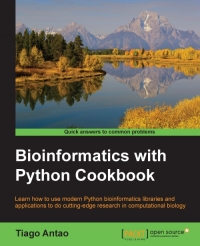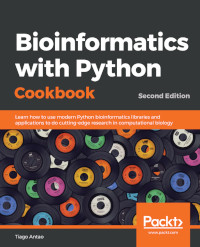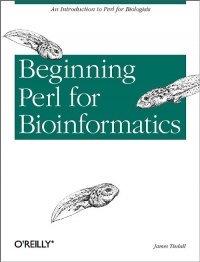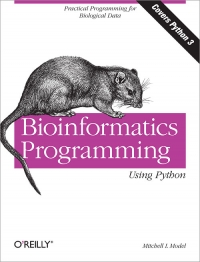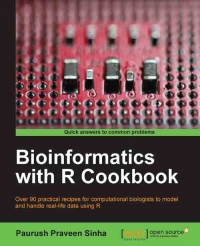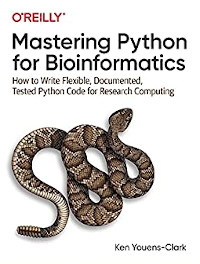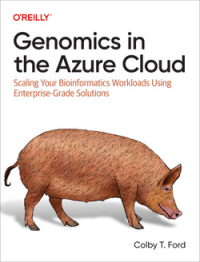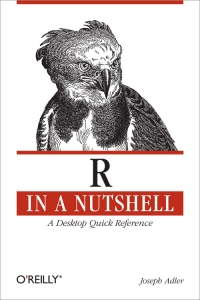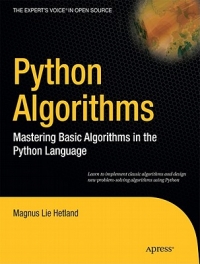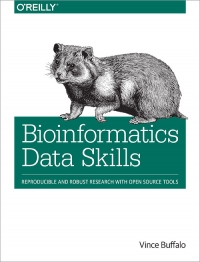Bioinformatics with Python Cookbook
If you are either a computational biologist or a Python programmer, you will probably relate to the expression "explosive growth, exciting times". Python is arguably the main programming language for big data, and the deluge of data in biology, mostly from genomics and proteomics, makes bioinformatics one of the most exciting fields in data science. Using the hands-on recipes in this book, you'll be able to do practical research and analysis in computational biology with Python. We cover modern, next-generation sequencing libraries and explore real-world examples on how to handle real data. The main focus of the book is the practical application of bioinformatics, but we also cover modern programming techniques and frameworks to deal with the ever increasing deluge of bioinformatics data. ...
If you are either a computational biologist or a Python programmer, you will probably relate to the expression "explosive growth, exciting times". Python is arguably the main programming language for big data, and the deluge of data in biology, mostly from genomics and proteomics, makes bioinformatics one of the most exciting fields in data science. Using the hands-on recipes in this book, you'll be able to do practical research and analysis in computational biology with Python. We cover modern, next-generation sequencing libraries and explore real-world examples on how to handle real data. The main focus of the book is the practical application of bioinformatics, but we also cover modern programming techniques and frameworks to deal with the ever increasing deluge of bioinformatics data. ...
Bioinformatics with Python Cookbook, 2nd Edition
Bioinformatics is an active research field that uses a range of simple-to-advanced computations to extract valuable information from biological data. This book covers next-generation sequencing, genomics, metagenomics, population genetics, phylogenetics, and proteomics. You'll learn modern programming techniques to analyze large amounts of biological data. With the help of real-world examples, you'll convert, analyze, and visualize datasets using various Python tools and libraries. This book will help you get a better understanding of working with a Galaxy server, which is the most widely used bioinformatics web-based pipeline system. This updated edition also includes advanced next-generation sequencing filtering techniques. You'll also explore topics such as SNP discovery using statistical approaches under high-performance computing frameworks such as Dask and Spark. By the end of this book, you'll be able to use and implement modern programming techniques and frameworks to ...
Bioinformatics is an active research field that uses a range of simple-to-advanced computations to extract valuable information from biological data. This book covers next-generation sequencing, genomics, metagenomics, population genetics, phylogenetics, and proteomics. You'll learn modern programming techniques to analyze large amounts of biological data. With the help of real-world examples, you'll convert, analyze, and visualize datasets using various Python tools and libraries. This book will help you get a better understanding of working with a Galaxy server, which is the most widely used bioinformatics web-based pipeline system. This updated edition also includes advanced next-generation sequencing filtering techniques. You'll also explore topics such as SNP discovery using statistical approaches under high-performance computing frameworks such as Dask and Spark. By the end of this book, you'll be able to use and implement modern programming techniques and frameworks to ...
Beginning Perl for Bioinformatics
This book shows biologists with little or no programming experience how to use Perl, the ideal language for biological data analysis. Each chapter focuses on solving a particular problem or class of problems, so you'll finish the book with a solid understanding of Perl basics, a collection of programs for such tasks as parsing BLAST and GenBank, and the skills to tackle more advanced bioinformatics programming. ...
This book shows biologists with little or no programming experience how to use Perl, the ideal language for biological data analysis. Each chapter focuses on solving a particular problem or class of problems, so you'll finish the book with a solid understanding of Perl basics, a collection of programs for such tasks as parsing BLAST and GenBank, and the skills to tackle more advanced bioinformatics programming. ...
Bioinformatics Programming Using Python
Powerful, flexible, and easy to use, Python is an ideal language for building software tools and applications for life science research and development. This unique book shows you how to program with Python, using code examples taken directly from bioinformatics. In a short time, you'll be using sophisticated techniques and Python modules that are particularly effective for bioinformatics programming. Bioinformatics Programming Using Python is perfect for anyone involved with bioinformatics - researchers, support staff, students, and software developers interested in writing bioinformatics applications. ...
Powerful, flexible, and easy to use, Python is an ideal language for building software tools and applications for life science research and development. This unique book shows you how to program with Python, using code examples taken directly from bioinformatics. In a short time, you'll be using sophisticated techniques and Python modules that are particularly effective for bioinformatics programming. Bioinformatics Programming Using Python is perfect for anyone involved with bioinformatics - researchers, support staff, students, and software developers interested in writing bioinformatics applications. ...
Bioinformatics with R Cookbook
Bioinformatics is an interdisciplinary field that develops and improves upon the methods for storing, retrieving, organizing, and analyzing biological data. R is the primary language used for handling most of the data analysis work done in the domain of bioinformatics. Bioinformatics with R Cookbook is a hands-on guide that provides you with a number of recipes offering you solutions to all the computational tasks related to bioinformatics in terms of packages and tested codes. With the help of this book, you will learn how to analyze biological data using R, allowing you to infer new knowledge from your data coming from different types of experiments stretching from microarray to NGS and mass spectrometry. ...
Bioinformatics is an interdisciplinary field that develops and improves upon the methods for storing, retrieving, organizing, and analyzing biological data. R is the primary language used for handling most of the data analysis work done in the domain of bioinformatics. Bioinformatics with R Cookbook is a hands-on guide that provides you with a number of recipes offering you solutions to all the computational tasks related to bioinformatics in terms of packages and tested codes. With the help of this book, you will learn how to analyze biological data using R, allowing you to infer new knowledge from your data coming from different types of experiments stretching from microarray to NGS and mass spectrometry. ...
Mastering Python for Bioinformatics
Life scientists today urgently need training in bioinformatics skills. Too many bioinformatics programs are poorly written and barely maintained, usually by students and researchers who've never learned basic programming skills. This practical guide shows postdoc bioinformatics professionals and students how to exploit the best parts of Python to solve problems in biology while creating documented, tested, reproducible software. Ken Youens-Clark, author of Tiny Python Projects (Manning), demonstrates not only how to write effective Python code but also how to use tests to write and refactor scientific programs. You'll learn the latest Python features and tools including linters, formatters, type checkers, and tests to create documented and tested programs. You'll also tackle 14 challenges in Rosalind, a problem-solving platform for learning bioinformatics and programming. - Create command-line Python programs to document and validate parameters - Write tests to verify refactor p ...
Life scientists today urgently need training in bioinformatics skills. Too many bioinformatics programs are poorly written and barely maintained, usually by students and researchers who've never learned basic programming skills. This practical guide shows postdoc bioinformatics professionals and students how to exploit the best parts of Python to solve problems in biology while creating documented, tested, reproducible software. Ken Youens-Clark, author of Tiny Python Projects (Manning), demonstrates not only how to write effective Python code but also how to use tests to write and refactor scientific programs. You'll learn the latest Python features and tools including linters, formatters, type checkers, and tests to create documented and tested programs. You'll also tackle 14 challenges in Rosalind, a problem-solving platform for learning bioinformatics and programming. - Create command-line Python programs to document and validate parameters - Write tests to verify refactor p ...
Genomics in the Azure Cloud
This practical guide bridges the gap between general cloud computing architecture in Microsoft Azure and scientific computing for bioinformatics and genomics. You'll get a solid understanding of the architecture patterns and services that are offered in Azure and how they might be used in your bioinformatics practice. You'll get code examples that you can reuse for your specific needs. And you'll get plenty of concrete examples to illustrate how a given service is used in a bioinformatics context. You'll also get valuable advice on how to: Use enterprise platform services to easily scale your bioinformatics workloads; Organize, query, and analyze genomic data at scale; Build a genomics data lake and accompanying data warehouse; Use Azure Machine Learning to scale your model training, track model performance, and deploy winning models; Orchestrate and automate processing pipelines using Azure Data Factory and Databricks; Cloudify your organization's existing bioinformatics pipelines ...
This practical guide bridges the gap between general cloud computing architecture in Microsoft Azure and scientific computing for bioinformatics and genomics. You'll get a solid understanding of the architecture patterns and services that are offered in Azure and how they might be used in your bioinformatics practice. You'll get code examples that you can reuse for your specific needs. And you'll get plenty of concrete examples to illustrate how a given service is used in a bioinformatics context. You'll also get valuable advice on how to: Use enterprise platform services to easily scale your bioinformatics workloads; Organize, query, and analyze genomic data at scale; Build a genomics data lake and accompanying data warehouse; Use Azure Machine Learning to scale your model training, track model performance, and deploy winning models; Orchestrate and automate processing pipelines using Azure Data Factory and Databricks; Cloudify your organization's existing bioinformatics pipelines ...
R in a Nutshell
Why learn R? Because it's rapidly becoming the standard for developing statistical software. R in a Nutshell provides a quick and practical way to learn this increasingly popular open source language and environment. You'll not only learn how to program in R, but also how to find the right user-contributed R packages for statistical modeling, visualization, and bioinformatics. The author introduces you to the R environment, including the R graphical user interface and console, and takes you through the fundamentals of the object - oriented R language. Then, through a variety of practical examples from medicine, business, and sports, you'll learn how you can use this remarkable tool to solve your own data analysis problems. ...
Why learn R? Because it's rapidly becoming the standard for developing statistical software. R in a Nutshell provides a quick and practical way to learn this increasingly popular open source language and environment. You'll not only learn how to program in R, but also how to find the right user-contributed R packages for statistical modeling, visualization, and bioinformatics. The author introduces you to the R environment, including the R graphical user interface and console, and takes you through the fundamentals of the object - oriented R language. Then, through a variety of practical examples from medicine, business, and sports, you'll learn how you can use this remarkable tool to solve your own data analysis problems. ...
Python Algorithms
Python Algorithms explains the Python approach to algorithm analysis and design. Written by Magnus Lie Hetland, author of Beginning Python, this book is sharply focused on classical algorithms, but it also gives a solid understanding of fundamental algorithmic problem-solving techniques. The book is intended for Python programmers who need to learn about algorithmic problem-solving, or who need a refresher. Students of computer science, or similar programming-related topics, such as bioinformatics, may also find the book to be quite useful. ...
Python Algorithms explains the Python approach to algorithm analysis and design. Written by Magnus Lie Hetland, author of Beginning Python, this book is sharply focused on classical algorithms, but it also gives a solid understanding of fundamental algorithmic problem-solving techniques. The book is intended for Python programmers who need to learn about algorithmic problem-solving, or who need a refresher. Students of computer science, or similar programming-related topics, such as bioinformatics, may also find the book to be quite useful. ...
Bioinformatics Data Skills
Learn the data skills necessary for turning large sequencing datasets into reproducible and robust biological findings. With this practical guide, you'll learn how to use freely available open source tools to extract meaning from large complex biological data sets. At no other point in human history has our ability to understand life's complexities been so dependent on our skills to work with and analyze data. This intermediate-level book teaches the general computational and data skills you need to analyze biological data. If you have experience with a scripting language like Python, you're ready to get started. ...
Learn the data skills necessary for turning large sequencing datasets into reproducible and robust biological findings. With this practical guide, you'll learn how to use freely available open source tools to extract meaning from large complex biological data sets. At no other point in human history has our ability to understand life's complexities been so dependent on our skills to work with and analyze data. This intermediate-level book teaches the general computational and data skills you need to analyze biological data. If you have experience with a scripting language like Python, you're ready to get started. ...
